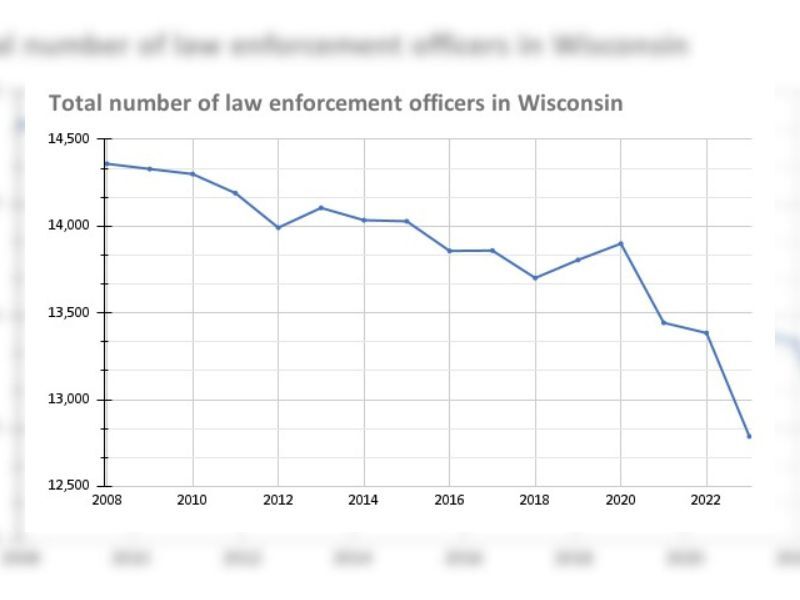Following the slide across the country, the total number of law enforcement officers in Wisconsin continues to decline to record lows.
The number of officers in Wisconsin fell again to less than 13,000 in 2023, according to data from the Wisconsin Department of Justice. That’s the lowest number of officers in the state since at least 2008, when the state DOJ started keeping track. That year, the total number of officers in the state sat at nearly 14,500.
The number has been sinking since at least then.
To get a better idea of how many officers are out patrolling the streets, these numbers exclude officers working exclusively in county jails and juvenile detention facilities. But those numbers continue to sink as well.
Though this “cop crunch” has been a nagging problem for years, the recent tight labor market for all employers has made things worse for law enforcement, experts say.
The number of nonfarm jobs, private jobs, and employment in Wisconsin each hit all-time highs in early 2024, according to the Department of Workforce Development.
While the U.S. unemployment rate remained at 3.7%, that rate in Wisconsin sat lower at 3.2%, close to its record low of 2.4% from last year. The national labor force participation rate of 62.5% was several points below the state rate, which perched at nearly 66%.
Chiefs and sheriffs say the life of a law enforcement officer is less appealing to younger folks who don’t want to work weekends, holidays and mandatory overtime.
And the field of law enforcement has suffered a popularity hit in recent years after high-profile abuses by officers and corresponding protests.
While private employers have been able to respond to the competitive job market by rapidly increasing their wages, the public sector cannot move so quickly, as government only budgets once per year.
So local governments across the state are scrambling to increase wages for law enforcement officers.
Pay raises to stop the bleeding
In the most recent state budget for 2024 and 2025, legislators increased state funding to local governments, many of which are using it to hire new officers or give pay raises to their law enforcement staff.
According to the terms of the state funding increase, the city of Milwaukee will get $200 million and must hire about 100 more police officers within ten years. The mayor says the city will do that sooner, as the Milwaukee Police Department has lost hundreds of cops in recent years.
On the other side of the spectrum, the Village of Mount Horeb in Dane County, with a population of 7,682 at the most recent Census estimate, added a new police officer to its staff paid by the increase in funding from the state.
The legislature also raised the starting wages of state prison guards to $33 per hour in hopes it can better recruit and retain its workforce.
Starting in January, Milwaukee County raised the hourly wage of its jail officers in the sheriff’s office from about $26 to $30, said James Burnett, a spokesman for the office.
Just a few months into the year, that move has already had the intended effect, Burnett said, increasing the number of job applications and broadening the candidate pool.
Nonpolice emergency response growing in Wisconsin
As the number of folks interested in being law enforcement officers has waned, many local governments are hiring nonpolice responders and launching teams to respond to some nonviolent emergency calls. These employees and teams can take some calls off the plate of a potentially overworked and understaffed police department, experts say.
The city of Madison has launched a Community Alternative Response Emergency Services, or CARES, team that has become so popular they are now expanding it across the county. The CARES team consists of an EMT from the Madison Fire Department and a mental health crisis worker who respond to “behavioral health emergencies.”

The city of Madison’s Community Alternative Response Emergency Services, which has recently expanded to three, 2-person teams consisting of an EMT and a mental health crisis counselor. Photo courtesy of the Madison Fire Department.
Many law enforcement agencies have hired social workers or crisis counselors. The Waukesha County Sheriff’s Department employs two crisis counselors who answer appropriate calls, said Inspector Jim Gumm, reducing some of the call volume for deputies.
The Superior Police Department is expanding its own nonpolice emergency response by hiring a second community response specialist, to focus on things like homelessness, addiction and chronic mental illness, said Mayor Jim Paine.
The city of Wausau and Marathon County share a Crisis Assessment Response Team, which partners plain-clothes officers trained in crisis intervention with two crisis counselors.
Experts say the nonpolice emergency responders not only relieve some of the call volume for law enforcement, but can also save money by proactively managing potential problems in the community and cutting back on things like overtime for officers.
The Badger Project is a nonpartisan, citizen-supported journalism nonprofit in Wisconsin.
Last Update: Apr 11, 2024 4:51 pm CDT

















